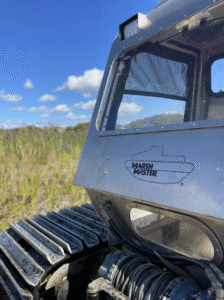Phragmites: The Marsh Master Program
![]()
The Marsh Master Program
One of the most effective tools in our fight against Phragmites australis is the Marsh Master, a unique amphibious machine designed specifically for wetland management. The Fishers Island Conservancy works with The Pond and Lake Connection, who operate this equipment as part of their professional restoration services.
What It Is
The Marsh Master is a low ground-pressure amphibious vehicle that can travel safely across tidal marshes, stump-filled swamps, and floating wetlands. Unlike traditional heavy equipment, it minimizes soil disturbance and allows access to areas that are otherwise unreachable.
What It Does
With the Marsh Master, crews can:
-
Mow and chop invasive plants, including tall Phragmites stands

-
Cut roots and rhizomes, weakening reed regrowth
-
Apply aquatic herbicides in a controlled and targeted manner
-
Assist with wetland trenching, debris removal, and mosquito abatement
-
Transport personnel and equipment safely through fragile marshes
These combined capabilities make the Marsh Master a cornerstone of modern wetland restoration.
Why It Matters for Fishers Island
On Fishers Island, Phragmites often grows in sensitive marsh areas where standard machinery cannot go. The Marsh Master allows our partners to treat invasive stands without damaging the wetland floor. This approach not only clears invasive reeds but also gives native plants a chance to recover.
The Pond and Lake Connection has used the Marsh Master across the Northeast, from Easton to Norwalk and Brookfield, Connecticut, with impressive results – transforming dense monocultures of reeds into recovering marshes that support biodiversity.
See examples: Before & After Projects
A Note of Caution on Cutting
Some property owners may choose to cut back small stands of Phragmites themselves. While cutting can temporarily reduce stalk height, this method alone will not eliminate the plant, the underground rhizomes remain alive and will regrow.
If you attempt cutting:
-
Cut at or just above ground level using sharp scissors, shears, or a weeding sickle.
-
If you use a brush cutter or weed whacker, cut a few inches above the ground to avoid harming small mammals or native vegetation.
-
Cutting in late fall or after the ground has frozen reduces regrowth potential.
-
Always clean equipment and clothing thoroughly afterward to avoid spreading rhizomes or seeds to new areas.
For long-term results, however, professional treatment is essential. That’s why the Conservancy partners with The Pond and Lake Connection, whose trained staff combine mechanical cutting, root disruption, and carefully targeted herbicide use. Their methods minimize chemical reliance, protect native species, and give wetlands the best chance to recover.